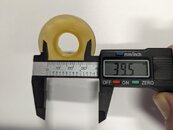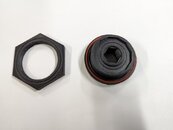Several thoughts on this thread.
I've been repairing BCDs with broken flanges already for 4 years and I have repaired more that 350 BCDs of different brands and models without any complain, not only for end divers, but also for dive schools, Fire fighters, police departments and some other security institutions.
For this I 3D print flanges. With the correct design, the correct material and the correct printing procedure I could achieve the required service level.
The original flange seems not to have the required durability and dependability.
No BCD manufacturer sell any spare for that part. Even old Scubapro BCDs, that used the same method to attach the flange, sell no spares.
This is al old SP flange with valve (similar solution for the power inflator) :
The general rule is that the manufacturer will recommend to dispose the BCD and buy a new one, even without any discount.
In modern BCDs, flanges are RF welded. No glue, no epoxi. Cordura is hard to glue to anything.
Replacement flanges must be fixed mechanically and sealed. The one that the OP did is one example, ScubaFix (
Scuba-Fix – scuba solutions made easy) is another, though this last one seems to be mold injected instead of 3d printed.
Sealing can be done with o-rings like the one used by the OP, but the original wing welded to the bladder should be perfect, which is not normaly the case.
Many times I had to remove the rest of the wing that is welded to the bladder by pieces, so an o-ring will not fit nor seal. Some times the cordura of the bladder is torn around the hole.
The following point to address is the size of the wing of the new flange. If it's small enough to be able to enter by the bladder hole, you risk for a leak. If it's wide enough to embrace the old wing and get a good mechanical anchorage, it would be hard to impossible to introduce by the hole in the cordura, so a solution has to be find. I've found what I think is the best solution.
Replacement flanges can be done by three methods (at least what I understand) :
- a plastic block lathed
- mold injected
- 3D printed
Each one has it's advantages and disadvantages.
1) Plastic block lathed
The size should be big enough to avoid deformations during machining. Complex forms are hard to get. Resistance is not an issue. Precision could be a problem. I've replaced lots of this type of flanges because it leaked or the valve or inflator was too loose.
2) Mold injected
A big amount of pieces should be injected to be price competitive. The mold is too expensive to build. Adjustments after the mold is done are also too expensive. Resistance and precision are not issues. A mold for each brand and model is required. A huge investment for a small business.
3) 3D printed
FDM 3D prints are anisotropic, so stresses in the Z-axis direction do not hold up well. Using the right material, with the right design and printed in the right way, that problem can be overcome. Accuracy must be adjusted with each printer. Complex forms are not a problem. Customization is not a problem.
Of course, a new BCD is better, but it's expensive, it's not good for your wallet and for the environment. and, of course, in the next years to come it will also break in the flanges, before you think is time to be changed.
Throwing away a BCD that is pristine, buy has one flange broken seem to be a crime.
The last question is "Will you trust in a repaired BCD ?"
Well, knowing what's going on with the original flanges I could argue "will you trust in a BCD not yet repaired, knowing that flanges break so much ? It seems that original flanges are not designed to last.
And a final point. It is said that scuba gear is "life support equipment". I think that a well trained diver should have the tools to survive even with a brutal gear malfunction.








